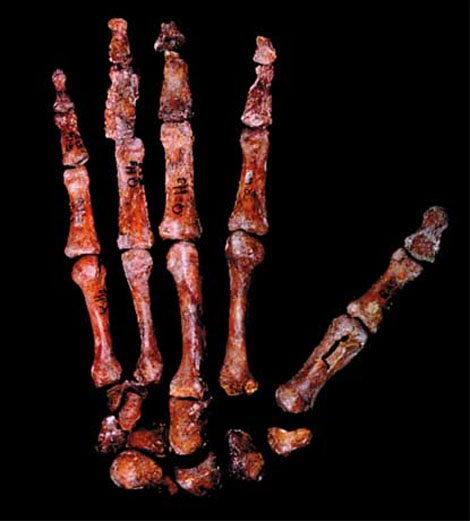

This matters because when we find ancient human hand fossils that preserve their internal structure, we can work out if they were probably swinging from trees during their lifetime or if they were walking on the ground more like humans today.’ Fossil hand bones two million to three million years old reveal this shift in specialization of the hand from locomotion to manipulation. The human hand is shorter than the foot, with straighter phalanges. Mr Dunmore said: ‘For the first time we see interesting internal bone patterns differentiating subtle differences between chimpanzee and gorilla knuckle-walking, as well as arboreal grasping in orang-utans. The chimpanzees hand and foot are similar in size and length, reflecting the hands use for bearing weight in knuckle walking. The information will now enable scientists studying fossils to better understand whether ancient humans were swinging from trees or walking on the ground. The researchers found the knuckle joints of orang-utans were consistent with flexing the knuckles while grasping branches, while the joints of chimpanzees, bonobos and gorillas were consistent with knuckle-walking – the most frequent ways in which these animals move around in their respective environments.

The study compared the internal bone structure of the knuckle joints in chimpanzee, bonobo, orang-utan and gorilla hands, to assess whether this bone structure records how these apes moved when knuckle-walking on the ground or hanging from trees. A chance discovery made by looking at a cast of the bones of Lucy, the most famous fossil of Australopithecus afarensis, shows her wrist is stiff, like a chimpanzee’s, Brian Richmond and David Strait of George Washington University in. When it is preserved in fossils, researchers can learn more about how ancient apes as well as humans moved and interacted with their environment. In addition, Lucy had a locking hand joint, while people are designed with a non-locking hand joint. Trabecular bone is a honeycomb structure that is found within most bones and changes depending on what that bone is used for during a lifetime. Internal bone structure reveals the patterns and directions of forces operating on the hand, providing clues to the kinds of activities performed. Using samples from the Powell-Cotton Museum in Birchington-on-Sea (UK), as well as samples from Germany, Belgium and the USA, a team led by School of Anthropology and Conservation (SAC) PhD student Christopher Dunmore examined the internal bone structure, called trabeculae or cancellous bone, of great apes. analyzed the internal bone structure of Pliocene Australopithecus hands, dated at 3.2 million years old. Research carried out by the University has found differences between the knuckle joints of primates that will enable a better understanding of ancient human hand use.


 0 kommentar(er)
0 kommentar(er)
